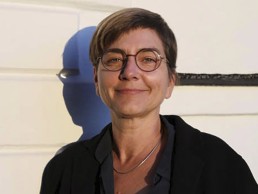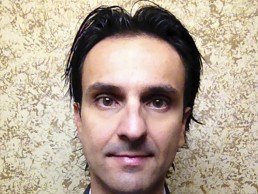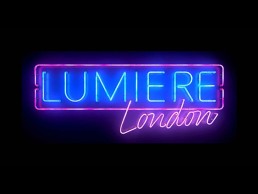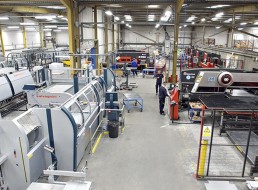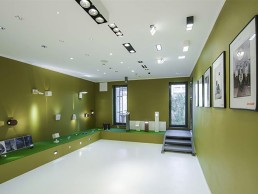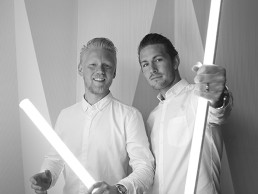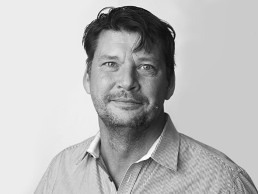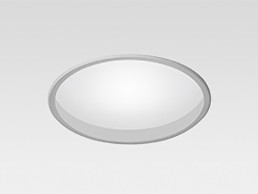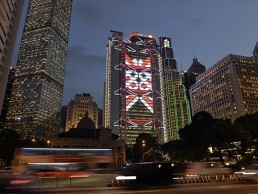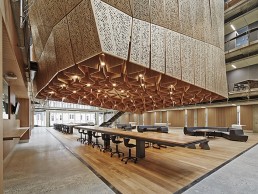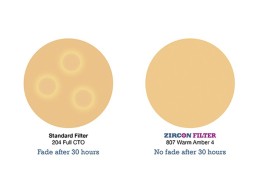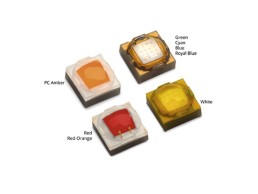Cecilia Ström joins ÅF Lighting
(Sweden) - As Group Manager of Architectural Lighting, Cecilia Ström will focus on encouraging dialogue and cooperation between architects and lighting designers.
Senior lead architect Cecilia Ström, previously of Wingårdhs and White Architects, has joined the ÅF Lighting team in Stockholm. Passionate about light and lighting, she aims to connect architects and lighting designers, creating closer cooperation between the two professions.
Cecilia Ström's job title at ÅF Lighting is Group Manager Architectural Lighting. This entails heading up a group of lighting designers, but she will also contribute in other ways.
Daniel Strömberg, Manager of ÅF Lighting in Stockholm, explained:"Cecilia took an active part in making Wingårdhs the premier architects' business that it is today. A few years ago, we set out on a similar path, and therefore Cecilia will be of great help to us in establishing ourselves as the preferred partner for lighting design in and around buildings. She will greatly contribute to the task of developing our processes and our range of services, she will strengthen our role in projects and help move lighting design up the agenda among architects, developers and project managers."
Ström particularly looks forward to broadening her skills and experience. She commented: "Although I am an architect, as opposed to a lighting designer, light has been pivotal throughout my career and with each project it has come to mean more to me. As I am curious by nature, I regard this opportunity to deepen my knowledge of light and daylighting as a great privilege."
In her new role, she will focus on encouraging dialogue and cooperation. "I hope that my experience from complex building projects, my insight into the reality of architects and my extensive network will strengthen ÅF Lighting. Creating a building is a process, and I will strive to make lighting design enter into it at an earlier stage than before," said Ström.
Targetti USA appoints new Vice President of Sales
(USA) - Antonio Cuccoli brings wealth of experience to help new North American operations for the Targetti Group expand US presence and ability to deliver projects around the glob
Targetti USA, the new North American operations for the Targetti Group, has appointed Antonio Cuccoli, Vice President of Sales - North America.
“We are extremely excited about Antonio joining our new team at Targetti USA. He brings with him a wealth of experience and knowledge in architectural lighting from both a US and International perspective,’’ commented Marie Paris, U.S. Business Development Manager, Targetti USA.
"Antonio has spent the last eight years serving in a Sales Management capacity for Targetti so he is innately familiar with our products and he will now represent Targetti USA serving as the Vice President of Sales for North America. His new role will help our new independent sales organisation maximise and expand our US presence and ability to deliver and support projects around the globe."
Cuccoli will be responsible for the creation of sales and business development for Targetti and DuraLamp products through specification sales, retail accounts, national accounts and working directly to support Targetti USA Sales Representatives. He will be working closely with these vertical markets across the US and internationally, to acquaint them on new and custom lighting solutions from both Targetti and DuraLamp brands.
Cuccoli has served in many capacities within the lighting industry most recently serving as a lighting-sales representative in the North East Region for Targetti Poulsen USA. As a Regional Sales Manager, Cuccoli worked on a variety of both local and international projects covering retail, residential, industrial, corporate and commercial applications. He is an active member of the lighting design community and holds a Business Management & Administration degree. With this deep knowledge of all aspects of the industry, as well as his language capabilities (English and Italian), Cuccoli's experience provides a unique perspective to fully serve the clients and representatives of Targetti USA.
Mayor of London welcomes Lumiere London
(UK) - New major international light festival from Artichoke to bring more than 20 artists to London's West End and King's Cross in January 2016.
The Mayor of London has welcomed the first Lumiere light festival, taking place over four nights from 14-17 January 2016. Lumiere London will be a free-to-attend event, produced by Artichoke and supported by the Mayor of London and VisitLondon.com, with founding support from Bloomberg Philanthropies, Heart of London Business Alliance and King's Cross, and additional support from a raft partners and sponsors.
Lumiere London will be the first major light festival in the city, an event to rival international festivals such as Vivid Sydney, Berlin's Festival of Lights and Fête de Lumières in Lyon. It will take place over four evenings across more than 20 landmark locations in London's West End and King's Cross.
Artichoke, one of the UK's leading creative companies, has produced a biennial Lumiere festival in Durham since 2009. It has unveiled the programme for the fourth Lumiere festival in Durham, 12-15 November 2015. Taking place during UNESCO’s International Year of Light and Light-based Technologies, Lumiere is commissioned and funded by Durham County Council with additional support from Arts Council England and a raft of sponsors.
The fourth Lumiere festival will see some of the world’s most eminent artists transform Durham City’s unique urban landscape and architecture into a magical nocturnal adventure. Artists include Janet Echelman from the US, Fujiko Nakaya from Japan, Catherine Garret from France, as well as two French pioneers of digital art, Miguel Chevalier and Patrice Warrener.
Alongside international artists, County Durham’s residents will be playing a starring role in this year’s festival. Working in collaboration with Lumiere artists locally produced ideas include Home Sweet Home and Precious. More than200 local people will also help Durham shine as they take on the role of Festival Makers, supported this year by Northumbrian Water.However, this is the first time the company has brought the concept to London. Pioneering international artists have been commissioned to create works for the festival, giving visitors and Londoners the opportunity to see the city in a new light.
This new festival will reinforce London's global reputation as a leader in culture and the arts and is expected to draw visitors to the capital from the UK and around the world at a traditionally quieter time of year.
The sites for the installations will include some of the city's most iconic buildings and locations. As with all Artichoke projects, an element of surprise will be integral to the experience and the exact locations will remain under wraps until closer to the time.
British artist Julian Opie has been commissioned to make a major new work especially for the festival, supported by Shaftesbury PLC. He will join more than two dozen international artists, performers and designers who have been invited to transform London's iconic streets and architecture using the medium of light. US artist Janet Echelman combines ancient craft techniques with cutting edge technology for her vast aerial net sculptures inspired by natural phenomena. 1.8 London is a new work constructed from thousands of feet of knotted twine. The sculpture is inspired by the 2011 Japanese Tsunami, which sped up the earth's vibrations and temporarily shortened the length of the day by 1.8 micro-seconds. Floating high above a central London meeting point, the delicate simplicity of Echelman's work belies the architectural precision and complex rigging involved. Audiences will be able to change its light and patterns via a specially-created App, powered by Atom Bank.
Paris-based Irish artists Anne Cleary and Dennis Connolly use innovative new technologies to make huge interactive projections and describe their work as ‘observer participation'. Cleary Connolly's Joining the Dots is a new commission by King's Cross, developed from the artists' recent collaboration with perceptive psychologists and composed with people from the local community. BinaryWaves by Belgian art-studio LAb[au] has its roots in the cybernetic art of the 1960s. Transposing the electromagnetic waves that carry telecommunications into light, sound and motion across 40 undulating illuminated panels, the work responds to the everyday rhythms of the city.
Helen Marriage, Artichoke Director and curator of Lumiere London said: "Lumiere London is the first Artichoke event in the capital for six years and marks the opening of our 10th anniversary year. Free and accessible to all, it brings great art out onto the streets, beyond the closed spaces of the gallery or the concert hall".
"Lumiere was born in Durham and its incredible success has been recognised across the world. Lumiere London will be a very different event with its own artistic programme, but the principles remain the same".
The Mayor of London, Boris Johnson, said: "Lumiere London will be a dazzling new festival for the capital, designed to expel the post-Christmas blues and bring a much needed fillip for businesses and the public during dark and dreary January. It's another example of our city's creativity and its unrivalled cultural riches, which draw visitors from around the world and bring billions to our economy."
Artichoke are working with Team London, the Mayor's volunteering programme for London, to recruit over 200 volunteers from across the capital to help make the festival a success. From sharing knowledge of the city and recommending places to eat and drink, to helping audiences discover more about the art works.
Dextra invests in future
(UK) - British lighting manufacturer purchases three metal working machines from Italian machine tool producer Salvagnini.
In line with long standing policy of investing in British manufacturing, Dextra has purchased three highly efficient metal working machines produced by its long standing supplier partner, Salvagnini S.p.A., the Italian machine tool producer. While the new S4 punch and 3.2-metre P4 folder are replacement for aging equipment, the high capacity S2 punch is additional. The company currently operates the only other S2 in the UK.
Already in 2015, an additional high capacity compactor has been installed to cope with increased volume for group subsidiary Dexreco Recycling and the R&D division is recipient of a new integrating sphere required for the accurate testing of in-house produced LEDex light engines.
The recent acquisition of an adjacent property and planning permission allows for a purpose built HGV vehicle maintenance area and the installation of equipment to allow the company to be self-sufficient in packaging.
Total expenditure is likely to be in the region of £2.5million and will be funded from the company's own resources. All of the above will be operational by February 2016.
Artemide expands
(Italy) - Design-oriented Italian lighting manufacturer continues to grow with new flagship stores in Chicago and Warsaw.
Artemide continues to grow with new flagship stores in Chicago, US, and Warsaw, Poland, confirming its expansion strategy involving important cities and significant shopping districts.
Both designed by architecture firm Studio de Bevilacqua, the Chicago store is a 2,800sqft showroom, showcasing the full range of Artemide lighting solutions, including new products, iconic fixtures and the latest innovative lights for architectural projects.
Studio de Bevilacqua maintained the integrity of the industrial building, incorporating the existing structure and architectural details, like exposed brick walls and wooden ceiling beams, into the design. By adding walls to separate without enclosing display areas, there is a seamless flow from room to room. Suspended cloud ceilings allowed Artemide to display ceiling and suspended fixtures at a realistic height without compromising the original ceiling structure.
Three large windows on West Hubbard Street allow passersby to look in through the entire space. The showroom is designed to serve as an exhibition space and lighting competency centre. It serves as a meeting point and consulting space for design professionals working on residential, hospitality, office, retail and outdoor urban and landscaping projects.
Founder of Artemide Group Ernesto Gismondi commented: "The Chicago market has been integral to the growth of Artemide in North America. We are thrilled to re-open this location for the sophisticated consumers, interior designers and architects of Chicago. Through the new showroom we will showcase a wide array of products that reflect the lighting competences that the Artemide team has developed over the years."
Further to this, Artemide open the first branded showroom in Warsaw, Poland, including Central and Eastern Europe. In the centre of the city's university district, the showroom is hosted inside a historical building containing the Idea MM exhibiting venue, a partner in the introduction of Artemide in Poland and distributor of international furniture brands.
The showroom offers high-level technological solutions for the lighting sector and an overview of the highlights of the Design and Architectural, Indoor and Outdoor collections of the Artemide and Danese product range. Conceived to provide a comprehensive overview of Artemide appliances, the one-storey showroom features spaces designed according to different colour codes to introduce smart lighting projects, closely focused on sustainability and designed by international architects and designers.
A place providing the right solution for any project, the showroom stands as a reference point for designers, a lighting consultancy centre for architects and professional lighting designers, offering a blend of products, competence, and design. Lighting specialists can find interactive and multimedia catalogues, supported by digital services that ensure perfect energy management for a sensible use of lighting, including the TCO (Total Cost of Ownership) calculation system.
ÅF Lighting expands to Uppsala
(Sweden) - New recruits Andreas Wiil and Andreas Almstedt set up office on behalf of ÅF Lighting, strengthening its range of services in the region.
ÅF continues to grow its lighting business. In Uppsala, new recruits Andreas Wiil and Andreas Almstedt have recently set up office on behalf of ÅF Lighting.
For ÅF, lighting design and planning is a growing business area. Currently, ÅF has some 70 employees at offices in Stockholm, Gothenburg, Malmö, Oslo and Copenhagen. Recently, another two were recruited. They will be based at the ÅF office in Uppsala, where the company has established operations within the heating, ventilation and sanitation, electrical installations and urban planning departments. In other words, ÅF is strengthening its range of services in this region.
Wiil and Almstedt are Uppsala-based lighting designers with extensive experience. Both have studied lighting design in Jönköping and were previously employed by Projektel.
Wiil, a former ÅF employee, was the first to be asked, and quick to accept: “I enjoyed working at ÅF and have kept in touch with my old colleagues there, but I chose another employer as my daily commute was too long. Therefore, it was an easy decision when I was asked to form part of their new lighting unit in Uppsala.’’
As further co-workers were required, Wiil suggested his colleague Almstedt. The latter has participated in major infrastructure projects and is also a licensed electrician, with five years experience of electrical installations.
Almstedt commented: “It felt like a set-up with good prospects. We know each other well, we work well together and share an approach to lighting matters. Also, there is a demand for good lighting design here in Uppsala!’’
Daniel Strömberg, ÅF Lighting Manager in Stockholm, was the one to initiate the expansion: “We have recruited two very competent individuals to strengthen our presence in this expansive region.’’
“There is plenty of construction going on in and around Uppsala: housing, offices, hospitals, infrastructure and several new sports arenas. Consequently, we see a great demand for our expertise which makes it logical to expand our lighting business to this location. I have high hopes that it will result in many interesting new projects and fruitful partnerships,’’ continued Strömberg.
Ronnie Eriksson joins ÅF Lighting
(Sweden) - Chairman of Swedish Lighting Industry Association's LED section to take on specialist role with responsibility for standards, smart city solutions and ÅF Lighting Academy.
Ronnie Eriksson, an experienced and multi-skilled individual in the industry, has joined the lighting team at ÅF. Previously with the Zumtobel Group, he is renowned for his expertise within LED, standards, training, lighting concepts and product and business development. He is the author of several publications and is much in demand as a speaker. For many years, Eriksson has been a dynamic force in various sections of the Swedish Lighting Industry Association, as chairman of their LED section, for instance.
Daniel Strömberg, Head of Business Area Lighting in Stockholm, is enthusiastic about the appointment: "Ronnie Eriksson is one of the foremost experts in this sector and it's fantastic to welcome him on board at ÅF. I have high expectations as regards what he will bring to our team and our customers with his high level of knowledge, his energy and commitment. Having Eriksson with us is testament to our appeal and strength as an employer."
At ÅF, Eriksson will take on a technical specialist role with responsibility for standards, smart city solutions and ÅF Lighting's future training programme, ÅF Lighting Academy. He will be based at the company's Stockholm office.
“I'm proud to be part of ÅF and I see this move as an opportunity to take on new challenges and develop professionally. I want to use my new role to share my many years of experience in the industry and take an innovative approach to helping the company identify new sources of income,’’ said Eriksson.
Reggiani Trybeca
The warm dimming version of Reggiani’s Trybeca recessed mounting fixtures is ideal for diffuse downlight applications in hotels and restaurants, wellness facilities and residential buildings. This latest version is the first of a series of products that changes the colour temperature of the light and the luminaire can be dimmed from 2,000 to 3,000K, keeping a high and steady CRI (up to 97).
HSBC Building, China
The Hong Kong and Shanghai Banking Corporation first opened its doors for business in Hong Kong in March 1865. In 150 years of trading, the bank’s headquarters became a stalwart symbol of prosperity and stability, standing on the same site in Central at number One Queens Road. Three magnificent structures have stood on this spot, none more world famous than the last edifice, designed by Norman Foster and built in 1985. So what better way of celebrating this company’s endurance and strength than by a commemorative revamping of its flagship building?
HSBC kicked off its 150th anniversary in Hong Kong with a three-part programme that included a digital makeover of its main building at One Queens Road, a commemorative HK$150 banknote and an interactive exhibition at the Hong Kong Maritime Museum.
Illumination Physics was commissioned to help bring to life the first wave of the 150th anniversary programme – the digital makeover of HSBC’s headquarters. The north façade of the building has been fitted with three high-resolution LED screens, which have been installed within the glass structure itself and are all but invisible during the day. However, at night these screens ‘come to life’. From 6.30 - 11pm they display images celebrating the city’s character as well as HSBC’s place within it, while also entertaining the nightly passers-by. These screens are so large and vivid that they can be seen from across the harbour in Kowloon.
With respect to the design and installation, it was clear from the start that it would not be enough to simply replace the existing façade lights with superior modern technology designs. Something new and remarkable was required. A grand visual statement was essential to mark the 150th anniversary and distinguish the building from all others taking part in ‘A Symphony of Lights’. A lengthy evaluation of the proposal ensued and a lighting plan was born of necessity.
With a six-month deadline, there was no time to completely re-wire the façade lighting and the existing power and data backbone was reused. Three new light fixtures were designed and manufactured by Illumination Physics specifically for this project. Custom versions of the manufacturer's Wash 48 and Wash 24 were designed so that they could be mated to the existing brackets without fuss, speeding up the work of Illumination Physics’ installation team. This was vital for the program; 90% of the façade lighting would be installed from the permanent gondolas and in a living building there is competition from a number of tasks requiring the external access equipment.
The lighting of this extraordinary building has always accentuated its main feature - the Exoskeleton, comprised of two ladder trusses that extend the full height of the building. Suspended from the ladders are the horizontal and diagonal brace elements of the Exoskeleton, measuring between twelve and eighteen-metres long.
Early in the design a decision was made to use RGBW fixtures allowing for a distinct improvement in colour variety and colour mixing capability. The IP Wash 48 was used for the grazing of the main members of the Exoskeleton; the major change to the fixture was in the use of composite lenses. These fixtures illuminate the Exoskeleton at very shallow angles. It is not possible to alter the height above the illuminated plane by extending the yoke, so two sets of lenses were created within the same fixture to cope with the extremely close mounting position and any possible aberrations. In order to properly deliver light to the illuminated surface closest to the luminaire, the twelve LEDs at the base of the fixture were fitted with an asymmetric 10º by 25º lens, this mitigates hot spots or shadows close to the fixture. The remaining 36 LEDs were fitted with 5º lenses to promote the longer throw of light along the linear Exoskeleton beams allowing for a more uniform composite effect. The ladder truss required a similarly improved wash light. The IP Wash 24 was used with a composite lens of 10º by 60º. This enabled the accurate lighting of the underside of each rung of the ladder without spill.
The refuge floors are another major feature of this building. These mandatory fire escape floors are wonderful open spaces; vast balconies affording magnificent views of Victoria Harbour and the city. Since 1983 the soffits above these double storey open floors had been illuminated as a feature. A wide angle lens version of Illumination Physics' IP Wash 48 was used, which resulted in more saturated, enriched and brighter colours. The replacement of the previous metal halide with LED dramatically reduced the electrical consumption with a saving of around 90%, depending on the programming of the dynamic display.
So the façade lighting had met its new objectives. How could the building now be used to celebrate the bank's 150th anniversary in 2015 and into the future?
Illumination Physics designed three media walls that were integrated into the glass façades between the refuge floors. The top screen measures five floors high, the centre screen measures six floors high and the lower screen covers seven floors. This seamless integration of equipment is all but invisible from the outside. A linear LED strip just 15mm wide was attached to the inside of the outer double-glazed glass layer. Throughout extensive testing, a variety of horizontal pitches were tested until the optimal compromise was found which provided more than 90% transparency for the vision glass panels. Illumination Physics created three vast media walls which can be used to create one composite image or three separate scenes. Every evening, these media walls awaken and visually communicate the tale of the 150 history of HSBC in a spectacular way.
The Exoskeleton HSBC main building is unique in more ways than one. It consists of large triangular shapes that coincidentally make up the HSBC logo. Media content was created on a black background that displays dynamic diamond and triangular kaleidoscopes that are a virtual metaphor of the building’s physical Exoskeleton. The media is always combined with the façade lighting and together they create a lighting display that is synergistic.
The Illumination Physics Systems and Control team faced many challenges when presented with the HSBC light show project. Not only were there 700 universes of DMX required for the mammoth task but these needed to seamlessly integrate with no visible lag in response times.
Illumination Physics specified a control system that would meet these requirements. It was decided early on that a high capacity low latency network was essential for the media screen and façade lighting control systems. Cisco equipment was chosen for the task of distributing 708 universes of DMX control via Artnet and sACN. The media wall alone requires a consistent 130-140mbps of Artnet traffic to be delivered with low latency and jitter across all 85 DMX nodes. System testing demonstrated 700us response times across the infrastructure thus avoiding any capacity and lag issues.
The capacity and design of the network allowed for multiple control systems to be effectively separated while using the same physical infrastructure, reducing overall costs as changes were made throughout the planning and commissioning phases of the project. Remote control was also required for various emergency procedures and monitoring. A fibre connection was supplied by HSBC for this purpose and allowed reliable time synchronisation for the system’s master clock, as well as various triggers from third parties to control the system remotely. A Cisco firewall was used to provide secure access solely to the required devices.
Longevity of the install was key criteria when selecting hardware for the project. All external components were chosen for known reliability and service back up. These devices needed to be compatible with a wide range of control protocols. The nodes allowed for future proofing as well as control changes if required through the run of the project.
The final commissioning of the system took place over January and February this year. Much of the lighting was programmed offline using Capture Argo, with final sign off live. The media content was also scheduled and added during the final commissioning period.
In effect, Illumination Physics has employed a media system to deliver architectural lighting, with the same treatment used to improve the building’s performance during the nightly ‘A Symphony of Lights’ performance. The media walls are used as animated lighting effects that ‘dance’ in time with the music in the citywide daily audio-visual display
Melbourne School of Design, Australia
Completed in 2014, Melbourne School of Design is the new home to the University of Melbourne’s Faculty of Architecture, Building and Planning. Described as a pedagogical building, it is setting new standards in education.
John Wardle Architects and Boston based architectural firm NADAAA designed the building after winning an international design competition conducted by the university. Electrolight was commissioned to work alongside these two notable firms in designing the specialist lighting scheme to many of the building’s common spaces, including the atrium.
The atrium is the heart of the building, cutting over four levels with a beautiful faceted timber ceiling, allowing natural light to flood the space below. The entire building is designed as an education tool, with its exposed structures and materials giving an insight into the fabrication and construction techniques used.
Custom designed spider pendants from Dean Phillips sit harmoniously in the space, providing functional illumination to the atrium through clusters of cone pendants. The design of these luminaires incorporates simple, repeated elements and multiple LED light sources to create a comfortable working environment.
One of the architectural feature elements of the atrium is the hanging studio, which is suspended from the ceiling and hovers over the main floor. This element provides a sense of scale and intimacy to the work area below. Lighting has been integrated into the fin detailing of the studio base, which reveals the materials and textures of the timber whilst providing functional illumination. This has been achieved through the use of Dean Phillips Exhausted LED surface-mounted downlights, positioned inside custom made polished aluminium tubes to conceal the luminaire, sprinklers and emergency lights.
The design of the vertical circulation allows the stairs to float within the atrium, supporting the architectural aspirations of a space supportive of the flow of creative ideas. The ambitious scissor stair connect the four levels from the atrium up, allowing students and staff to meander through the building. Internal timber cladding and cleverly integrated lighting details created by Electrolight, made up of a satinice diffuser and VueLite LED strip, that appear to escape from between the timber joins, provide a warm and intimate path of travel.
The lighting design was based on achieving appropriate light levels throughout and not overlighting. Efficient LED light fittings were specified to achieve this, resulting in the school of design achieving a 6-star Green Star rating by the Green Building Council of Australia and the first education building to be awarded 10 Green Star innovation credits.
Before taking on this project, Electrolight had a well-established, 10-year long relationship with JWA. “We are fortunate to have worked on interesting projects, however this was a great project with a great architect,’’ said Jess Perry, Director at Electrolight.
Given the nature of the project, to be involved in the creation of the school of design was always going to be a challenge as lots of people in the design industry would feel the need to offer their opinions, good and bad, adding an extra level of pressure.
As with all projects, lighting is a vital element in defining the space. Perry explained: “it needs to be carefully designed and integrated into the fabric of the space.’’ This ensured a seamless partnership between the architecture and lighting.
Within this partnership with the architecture, the lighting scheme looked to encourage a creative environment and extend the learning experience found amongst the school's students.
When asked about the main challenges faced during this project, Perry responded: “The atrium void was one of the main challenges. We designed various lighting schemes before the design team selected the custom pendant approach.’’
In order to achieve a balance between lighting the project in an efficient way and making the space inviting for students, Electrolight made sure that light distribution within the space was even and well thought out.
Perry continued: “The balancing of light distribution within a space basically sums up what we do as lighting designers. The architectural design by JWA provided us with many opportunities and combined with the various task requirements, the challenge wasn't to work out what to illuminate but rather what not to illuminate.’’
When asked about the selection of particular fittings, Perry explained: “The process that we use is to consider (a) light effects and how to achieve them i.e. light output, beam distribution, colour temperature etc. (b) quality (c) budget and (d) ongoing support.’’ With this in mind, LED light sources were selected, ensuring optimal energy saving measures were implemented in the school. The LED lighting to non specialist spaces was undertaken by electrical engineers Aurecon.
Electrolight's integrated lighting scheme for the atrium ensures a seamless partnership with the architecture, providing the space with a striking and functional illumination
LEE Filters Zircon Filters
A new range of lighting filters designed to offer quality, consistency and durability, Zircon circumvents the problem of filters that struggle with fade times when used in conjunction with LED lighting set-ups.
Zircon offers a selection of warming and diffusion filters. Designed to correct a variety of white tones, warm amber comes in a range of four strengths, while diffusion offers three filter strengths that act to blur pixels when placed in close proximity to the LED chip.
Lumileds Luxeon C Color Line
Lumileds’ Luxeon C Color Line reshapes its approach to colour mixing to deliver optically consistent colours and whites with unprecedented high centre beam candle power (or ‘punch’).
A platform has been designed to offer multiple colours with a single focal length. When secondary optics are applied, the consistent focal length maximises optical efficiency and provides matching emission patterns, enabling sleek colour mixing. Applications such as tall, narrow wall washers take advantage of Luxeon C Color’s low dome design, keeping the source size small and leading to higher punch.


